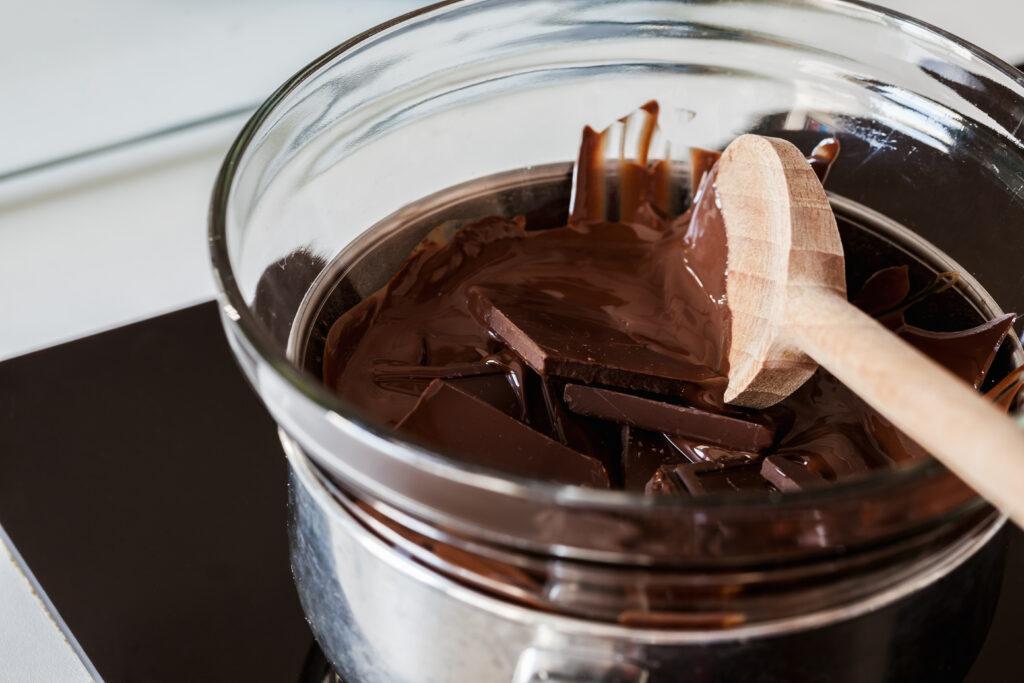Chocolate is one of the most beloved foods in the world, known for its rich flavor and creamy texture. Whether it’s enjoyed as a decadent dessert or savored in a steaming cup of hot cocoa, there’s no denying that chocolate is truly irresistible. But what exactly makes this delectable treat so unique? And how does the melting point of different types of chocolate differ?
The melting point of chocolate is a topic of much interest to chocolate lovers everywhere. This article will explore the various factors that affect the melting point of different types of chocolate, including cocoa content, temperature, and more.
Whether you enjoy milk, dark, or white chocolate, this post has all the information you need to understand why your favorite type of chocolate melts at a specific temperature. So what are you waiting for? Keep reading now to learn more about the melting point of chocolate!
Why Do We Care About Chocolate Melting Points?
The melting point of chocolate is the temperature at which chocolate changes from a solid to a liquid state. This is an essential concept for home cooks and professional chefs, as the right melting point can mean the difference between perfect chocolate dishes and disaster.
Cocoa butter is the fat component of cocoa beans, and it is what gives chocolate its smooth texture. When cocoa butter is heated, it melts and becomes liquid. As it cools, it solidifies again, and the process can be repeated.
The melting point of cocoa butter is around body temperature, which is why chocolate melts in your mouth. This is also why chocolate can be a little tricky to work with. The chocolate will become grainy and lose its glossy sheen if the temperature gets too high.
Too low, and the chocolate will be crumbly and hard to mold. This is where tempering comes in. Tempering is a process of heating and cooling chocolate to control its crystalline structure and achieve the best texture, flavor, and appearance.
The melting points of the various crystallization forms of cocoa butter are as follows:
| Types of Crystals | Melting Point | Taste Notes |
|---|---|---|
| Type I | 17.3°C | Soft, crumbly |
| Type II | 23.3°C | Crumbly, melts easily |
| Type III | 25.5°C | Firm but melts easily |
| Type IV | 27.3°C | Firmer but melts easily |
| Type V | 33.8°C | Best for eating: melts near body temperature, crisp snap |
| Type VI | 36.3°C | Too hard |
Melting Points for Different Chocolates
Chocolates can be classified into different types based on their cocoa content, including milk chocolate, dark chocolate, and white chocolate. Each of these types of chocolate has different melting points due to the varying proportions of cocoa butter, milk fat, and other ingredients.
Milk Chocolate
Milk chocolate falls into the chocolate category with 20-50% cacao solids, melting completely at 104- 113 degrees Fahrenheit or 40-45°C. This makes it an excellent choice for decadent desserts and treats that melt in your mouth, as its smooth texture ensures a superior taste experience.
Melting Point: 40-45°C, 104-113 °F
Dark Chocolate
The melting point of dark chocolate also depends on the percentage of cocoa solids in the chocolate. Generally speaking, the darker the chocolate, the higher its melting point will be. For instance, dark chocolate with about 86% cacao solids – has a higher melting point and won’t melt until the temperature reaches 115 degrees Fahrenheit or 46°C.
Melting Point: 46°C, 115 °F
White Chocolate
White chocolate has the lowest melting point of the three types due to its high proportion of powdered milk and milk fats. With no cacao solids and around 20% cocoa butter, it melts at temperatures between 99-109 degrees Fahrenheit or 37-43°C.
Melting Point: 37-43°C, 99-109 °F
How Can I Melt Chocolate Correctly?
Whether you’re melting chocolate for a recipe or to enjoy by the spoonful, there are a few techniques to ensure your chocolate melts smoothly and evenly every time. Here are some tips to help you get started:
- Use a double boiler: A double boiler is an effective way to melt chocolate without burning it. Place chocolate in a heat-resistant bowl over a pot of simmering water, making sure that the bottom of the bowl doesn’t touch the water. Stir your chocolate continuously as it melts to prevent overheating.
- Use microwaveable bowls: If you prefer not to use a double boiler, another option is to melt your chocolate in the microwave. Place your chocolate in a microwave-safe bowl and heat it on medium power for 30 seconds. Stir well, then continue heating and stirring in 15-second or 30-second intervals until your chocolate is completely melted and smooth.
- Work with small quantities of chocolate at a time: If you’re melting large amounts of chocolate, working in small batches is essential to avoid overheating. Start with a small amount of chocolate, and stir it continuously as it melts to prevent burning or clumping.
- Keep your chocolate at the right temperature: Ideally, it would be best if you melted your chocolate at around 90-95 degrees Fahrenheit or 32-35°C – a slightly lower temperature than what’s typically used in the kitchen. This will help prevent your chocolate from seizing when you add other ingredients or melt it with a hot liquid.
Finally, suppose you have some left over after you’ve finished your recipe or melted it for your desired use. In that case, you can pour the remaining chocolate into a small, lidded container and store it in the refrigerator for later. This will help maintain its texture and prevent it from clumping or developing an unpleasant, waxy taste.
Following these tips ensures you get the most out of your chocolate every time you melt it. When creating a decadent dessert or simply enjoying a delicious treat, melted chocolate will become one of your favorite ingredients!
Conclusion
Knowing the melting points of chocolate can help you to control the Chocolate making process much better. You can also use this information to temper your chocolate correctly. If you have ever wondered how professionals get that perfect glossy sheen on their chocolate, it is all about temperature and understanding the science behind it.
Now that you know more about the melting points of different types of chocolate, go out and experiment for yourself in the kitchen. Try tempering some chocolate at home and see what kind of results you can achieve. Thanks for reading.
FAQs
Which Type of Chocolate Has the Highest Melting Point?
Dark chocolate has the highest melting point of the three main types – dark, milk, and white chocolate. This is because it contains a higher proportion of cacao solids, which takes longer to melt and can withstand higher temperatures.
What Chocolate Has the Lowest Melting Point?
White chocolate has the lowest melting point since it contains no cacao solids and is primarily made up of milk fats, powdered milk, and sugar. Because it’s so easy to melt, white chocolate is also more prone to burning and seizing when you work with it. Therefore, it’s important to exercise extra caution when working with white chocolate in the kitchen.
Why Does Chocolate Need to Be Tempered?
Chocolate must be tempered to create the desired smooth texture and glossy sheen. The tempering process also helps to prevent the formation of white streaks or spots on the surface of the chocolate, a phenomenon known as “bloom.”
What Is the Melting Temperature of Chocolate?
The melting temperature of chocolates is between 86 and 90 degrees Fahrenheit. This means that chocolate will soften and become liquid at these temperatures. However, if chocolate gets too hot, it can begin to lose its flavor and become burnt. As a result, it is essential to be careful when working with chocolate so that it does not get too hot and ruin the finished product.
Do Different Types of Chocolate Melt Faster Than Others?
Yes, different types of chocolate melt at different rates.
Which Chocolate Melts Faster and Why?
Dark chocolate melts faster than milk chocolate because it has a lower cocoa butter content. Cocoa butter is a form of fat that contributes to the smooth texture and shape retention of chocolate at room temperature. When chocolate is heated, the cocoa butter begins to liquefy, causing the chocolate to melt. Because dark chocolate contains less cocoa butter than milk chocolate, so it melts more quickly when exposed to heat.
Is There a Trick to Melting Chocolate?
For the best results, chocolate can be melted in a double boiler or a bowl placed over a pan of simmering water. Stir frequently until the chocolate is smooth and melted. You can also melt chocolate in the microwave, but be sure to use a microwave-safe bowl and zap the chocolate in short bursts, stirring after each one, until it’s melted. And don’t overdo it—chocolate can scorch easily.
What Melts Faster, White or Dark Chocolate?
Dark chocolate tends to melt faster than white chocolate due to its higher cocoa butter content.
Why Won’t My Chocolate Melt Smoothly?
Chocolate can seize up or thicken when it’s overheated if cold substances are added or even if a small amount of liquid gets into it. This is because the sugars in the chocolate lump together and separate from the fat when these things happen rather than harmoniously melding together as they usually would.
To avoid this, be careful not to overheat your chocolate and not to add anything cold or wet to it while it’s melting.
What Type of Chocolate Keeps the Longest?
There is no definitive answer to this question, as chocolate’s shelf life depends on various factors, including its type and how it’s stored. Generally speaking, dark chocolate tends to be the most stable, while white chocolate contains more milk fats and can quickly go rancid if not stored properly.


